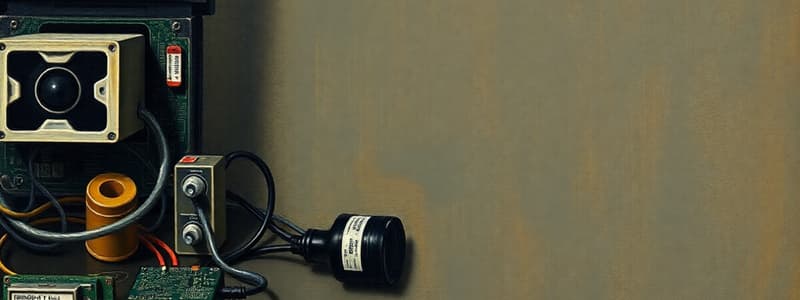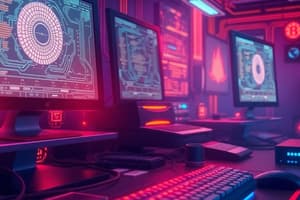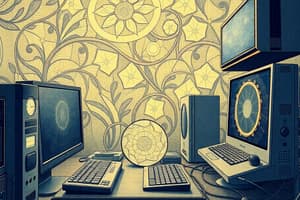Podcast
Questions and Answers
What is another name for a logic chip?
What is another name for a logic chip?
- Microprocessor (correct)
- Input Device
- Bus Interface
- Memory Module
The binary system represents data using multiple states.
The binary system represents data using multiple states.
False (B)
What is the term for loading the operating system into a personal computer?
What is the term for loading the operating system into a personal computer?
Booting
An ink-jet printer is an example of a(n) __________ printer.
An ink-jet printer is an example of a(n) __________ printer.
Which application is not typically included in an office suite?
Which application is not typically included in an office suite?
Match the following terms with their definitions:
Match the following terms with their definitions:
What does cache memory built into the CPU chip refer to?
What does cache memory built into the CPU chip refer to?
MS Access is considered an operating system.
MS Access is considered an operating system.
The main circuit board in a personal computer is called the __________.
The main circuit board in a personal computer is called the __________.
What is the processor speed for top-end personal computers typically measured in?
What is the processor speed for top-end personal computers typically measured in?
Which of the following is not considered to be a computer peripheral device?
Which of the following is not considered to be a computer peripheral device?
ROM is a type of computer memory that allows users to write new information.
ROM is a type of computer memory that allows users to write new information.
What is the term for a group of 8 bits?
What is the term for a group of 8 bits?
A __________ disk that stores digitized audio information is called a CD.
A __________ disk that stores digitized audio information is called a CD.
Which of the following is not a function of the Output Unit?
Which of the following is not a function of the Output Unit?
The size of the main memory mainly depends on the size of the address bus.
The size of the main memory mainly depends on the size of the address bus.
What does MAR stand for?
What does MAR stand for?
Data is the raw material used as input and __________ is the processed data obtained as output of data processing.
Data is the raw material used as input and __________ is the processed data obtained as output of data processing.
Which of the following is not a type of optical disk?
Which of the following is not a type of optical disk?
Flashcards
What is a port?
What is a port?
A computer part that allows data transfer between various devices and the computer.
What is ROM?
What is ROM?
A type of computer memory where data cannot be modified or overwritten.
What is a byte?
What is a byte?
A group of 8 bits, used to represent a single character.
What are device drivers?
What are device drivers?
Signup and view all the flashcards
What are the two main types of computer memory?
What are the two main types of computer memory?
Signup and view all the flashcards
What is a CD?
What is a CD?
Signup and view all the flashcards
What is outputting?
What is outputting?
Signup and view all the flashcards
What are plotters?
What are plotters?
Signup and view all the flashcards
What are drum printers?
What are drum printers?
Signup and view all the flashcards
What is a CRT monitor?
What is a CRT monitor?
Signup and view all the flashcards
Microprocessor
Microprocessor
Signup and view all the flashcards
Binary System
Binary System
Signup and view all the flashcards
Gigahertz
Gigahertz
Signup and view all the flashcards
Soft Copy
Soft Copy
Signup and view all the flashcards
Nonimpact Printer
Nonimpact Printer
Signup and view all the flashcards
OMR
OMR
Signup and view all the flashcards
Office Suite
Office Suite
Signup and view all the flashcards
PDF
Signup and view all the flashcards
Booting
Booting
Signup and view all the flashcards
L1 Cache
L1 Cache
Signup and view all the flashcards
Study Notes
Computer Components and Functions
- Peripheral Devices: The CPU is not a peripheral device. Peripherals are external devices that work with the computer.
- Data Transfer: Ports allow data transfer between devices and the computer system.
- Read-Only Memory (ROM): ROM is memory where users cannot write new information or instructions. It holds essential startup programs.
- Byte: A group of 8 bits forms a byte.
- Megabyte Conversion: 1 Megabyte equals 1,000,000 bytes.
- Device Drivers: Device drivers allow input/output devices to connect to the computer system.
- Memory Types: The two basic memory types are primary and secondary.
- CD-ROMs: A non-erasable disk that stores digitized audio is a CD.
- Outputting: Creating useful information for the user is outputting.
- Plotters: Plotters produce images or drawings.
- Drum Printers: Line printers that print one line at a time are drum printers.
- CRT Monitors: CRT monitors are traditional, television-like monitors often used with non-portable computers.
- Output Unit Function: Output units display data in a user-friendly format. They do not supply data and instructions to the computer for further processing.
- Bit: The smallest unit of data in a computer is a bit.
- Input Unit Function: Input units provide data to the computer for processing. They do not convert data into a user-friendly format.
- Data and Information: Data is raw input and information is processed data that is useful to a user.
- Computer Characteristics: A computer's characteristics do not include IQ.
- Memory and Address Bus: The size of main memory is influenced by the size of the address bus.
- Memory Address Register (MAR): MAR stands for Memory Address Register.
- Optical Disks: Optical disks use laser beams for data storage.
- Address Bus Independence: Secondary memory is independent of the address bus.
- Optical Disk Types: Winchester is not an optical disk type.
- Input Devices: Bar code readers are input devices.
- Primary Storage: Another name for memory (primary storage) is memory.
- End-Users: Computer users who are not professionals are end-users.
- Supercomputers: Supercomputers are the most powerful computers.
- Logic Chip Equivalent: A logic chip is a microprocessor.
- Data Representation: Binary is the two-state (on/off) system that represents data on a computer.
- Processor Speed: Processor speeds are measured in gigahertz (GHz).
- Soft Copy: Soft copy refers to screen output (visual display on a screen).
- Non-impact Printers: Inkjet printers are non-impact printers.
- OMR: "Mark sensing" is another name for OMR. OMR translates markings into machine-readable data.
- Office Suite Applications: Antivirus software is not typically included in an office suite.
- Adobe Acrobat File Format: Adobe Acrobat files are stored in PDF (Portable Document Format) format.
- Booting: Loading the operating system is booting the computer.
- Operating System Examples: MS Access is not an operating system. Examples are Windows, macOS, Linux.
- Cache Memory: L1 cache memory is built into the CPU chip.
- Register Length: The length of a register is the word size.
- Uniform Resource Locator (URL): A URL represents a website's address.
- Top-Level Domain: The most commonly used top-level domain is .com.
- Collaborative Software: Collaborative software is also known as groupware.
- Scrolling: Scrolling moves pages up or down on a screen.
- Motherboard: The main circuit board in a computer is the motherboard.
Memory and Storage
- Primary Storage: Primary storage is also known as memory.
- Types of Memory: QRAM is not a memory type. Examples are RAM, ROM, cache memory.
- Memory Types: Primary storage, secondary storage.
Additional Concepts
- Output Units: Output units present information in a usable format.
- Input Units: Input units gather data from the user.
- Data Processing: The process of converting data into usable information is called data processing.
- Computer Purpose: Computers process data and produce useful information for people using a variety of programs, applications, and hardware.
Studying That Suits You
Use AI to generate personalized quizzes and flashcards to suit your learning preferences.




